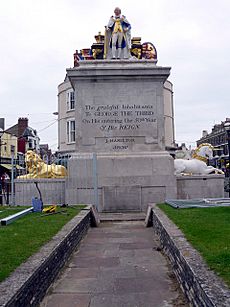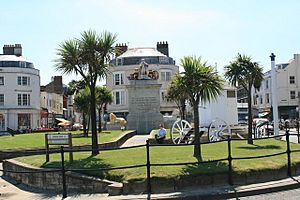King's Statue facts for kids
The King's Statue is a special statue in Weymouth, Dorset, England. It honors King George III, who was a very important king. This statue was put up in 1809 to celebrate his Golden Jubilee, which was the 50th anniversary of him becoming king. Many buildings along the seafront in Weymouth are in the Georgian style, which was popular during his time. The statue is a very important historical monument, listed as Grade I.
About the King's Statue
King George III loved visiting Weymouth. He came for holidays fourteen times, starting in 1789. Because the king enjoyed the town so much, Weymouth became very popular and grew a lot. Many of the buildings you see along the seafront today were built during his reign. The king was first advised to visit Weymouth to help him recover from an illness. His royal court came with him, and newspapers across the country reported on his visits.
How the Statue Came to Be
Because King George III showed so much interest in Weymouth, people decided to build a statue to honor him. The idea came up in 1802, and a design was quickly made by architect James Hamilton. However, the plan was put on hold when the king became ill again in 1805, and the statue was stored away. In 1809, it was the 50th anniversary of the king starting his rule, so the statue was finally put in place.
When the statue was first planned, it was meant to be lower down and in front of a building, so people could see its details better. But it ended up being placed high up and out of easy reach. It was put at the meeting point of two main streets, St. Mary Street and St. Thomas Street. Today, the statue is on an island in the middle of the road, close to the sea. It was actually delivered to Weymouth and put together four years before it was finally set up in its current spot.
Even though there were ideas to move it, the statue remains a key landmark in Weymouth. In the early 1900s, it became a place where people gathered for public events and celebrations, like coronations. However, when the statue's location became a traffic island in the late 1950s, it stopped being a central gathering spot.
In 2007 and 2008, the statue was cleaned and repaired. It had been damaged by vandalism, seaside weather, and 200 years of old paint and dirt. The local council, with money from the Heritage Lottery Fund, hired a company to restore it. They removed 20 layers of old paint, put on new paint, added gold leaf, and replaced the old iron frame with a new stainless steel one.
What the Statue Looks Like
The figures and details of the statue are made from a special material called Coade stone, created by the company Coade and Sealy. It stands on a huge base made of Portland stone. The King is wearing his fancy Garter robes and holds a royal staff called a sceptre in his right hand. Behind him, you can see the crown on a cushion, the royal flag, the British Union flag, a stack of books, and a large oval shield with a coat of arms. On each side of the main base, there is a lower pedestal with a lion on one side and a unicorn on the other.
The front of the statue has an inscription that says: "The grateful Inhabitants, to George the Third on his entering the 50th Year of his Reign." This means the people of Weymouth were thankful to King George III as he reached his 50th year as king.
The statue was originally painted to look like bronze. It only became multi-colored in 1948. Not everyone has always loved the monument. In 1886, a newspaper reporter even called it a "hideous monstrosity," showing that opinions about the statue have changed over time.



